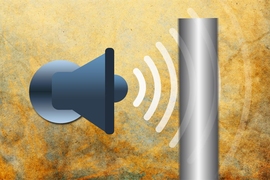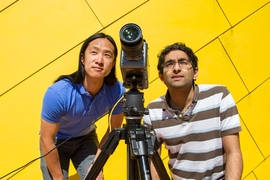For Justin Chen, a PhD student in the MIT Department of Civil and Environmental Engineering (CEE), there is more to observe in the built environment than meets the eye. So much more, in fact, that he has designed his entire academic attention in CEE to center on structural health monitoring.
“Everyday, people drive on bridges, enter buildings, obtain water through infrastructure, and so on,” Chen says. “The central question my collaborators and I are trying to answer is: How do we keep infrastructure operational, even when it’s battered by the elements?”
Although most would describe buildings as completely static, Chen says his work reveals structural movement the naked eye alone cannot perceive. Using a computer vision technique called motion magnification, Chen and his colleagues successfully catch imperceptibly tiny vibrations in structures.
This technique, Chen explains, will allow engineers to monitor the health state of this infrastructure, maintain it, and ultimately improve the sustainability of future infrastructure worldwide.
Now in his fifth year, Chen works in collaboration with MIT’s Computer Science and Artificial Intelligence Laboratory (CSAIL). He devises algorithms that observe small structural motions from videos on a research project sponsored by Shell through the MIT Energy Initiative (MITEI) with the principal investigators, Professor Oral Buyukozturk of CEE and Professor Bill Freeman of CSAIL and the Department of Electrical Engineering and Computer Science. Chen’s research will further contribute to a more comprehensive understanding of construction methods and materials for sustainable infrastructure by providing data to building managers who can arrange for repairs or more in-depth inspections.
By detecting more severe and costly damage and catching it at a less severe state, total repair costs could be reduced, and the service life of the structure improved, benefitting critical civil and industrial infrastructure. Additionally, any information Chen's team collects on a building’s behavior has the potential to contribute to design changes for better reliability and lifespan of future buildings.
Chen received his undergraduate degree in physics from Caltech in 2009. While working with MIT’s Lincoln Laboratory from 2009-2010, Chen realized his fascination with laser vibrometry and later jumped at the opportunity to work with Buyukozturk as a PhD student on his National Science Foundation (NSF)-supported project for measuring defects in concrete. He recently spoke with CEE about his work:
Q: What are the real world implications of your research?
A: For the past five years, I’ve worked on the challenges of structural health monitoring and non-destructive testing for the condition assessment of infrastructure in the context of two different projects: An NSF- and American Society for Nondestructive Testing-supported project on using laser vibrometry to measure defects in fiberglass reinforced concrete; and most recently a Shell and MITEI sponsored project called BeeView, which employs distributed sensing and motion magnification for detecting damage in structures.
In BeeView, we are attempting to uncover damage in buildings through sensors that measure the structural vibrations of buildings, which we then use to deduce the level of structural damage. My particular focus is using cameras to measure the vibrations of buildings, bridges, and other structures.
When you look at buildings, they’re fixed, stationary. With CSAIL, we’ve been able to use algorithms to observe structural motions from videos. From those small motions, we can get our displacements of these buildings and process them with other damage-detection algorithms.
Our work serves as an early warning for people who maintain these buildings. Theoretically, when we suspect damage, we can pass that information on to those who will repair the buildings and use the lessons learned to construct more sustainable infrastructure in the future.
Over the course of our exploration, we’ve built a model structure in our basement laboratory that we’ve measured with accelerometers and other sensors as a test-bed for our damage detection algorithms.
At the end of this project, we plan to have developed a piece of software, compatible with the camera, that analyzes a structure and determines how it’s changed over time.
Q: What opportunities have you had to delve deeper into your research?
A: In January, I traveled to Houston, Texas, along with other Shell-MITEI fellows, at the invitation of our sponsor, Shell. All of the fellows were invited to visit the testing facilities and explore the current research. It was one of the most memorable experiences during my time in Course 1 [CEE]. I learned about the oil industry — a sector with which I had no previous experience — and how my research with vibration analysis can be used to solve their future challenges.
In the oil business, there is a lot of infrastructure — pipelines, oil rigs, and refineries — which all need to be operational and protected. With the camera, I could measure those facilities and help to maintain and sustain their function.
Aside from visiting Houston, I’ve had the fortune to travel outside of the country to explore my research interests. Last fall, I went to Prague to the World Conference on Nondestructive Testing to present my previous research using laser vibrometry. I met with other international researchers in the field not only from Europe, but also from the Americas and Asia. I was able to discuss with them the ways in with our research compared and gain a different perspective on how to tackle our shared research problems.
In addition, I went to Istanbul last May as part of a collaboration with Istanbul Technical University (ITU) led by Professor Buyukozturk for a potential project in the field of structural health monitoring. ITU hosted a workshop where Professor Buyukozturk, his Turkish collaborators, and I gave technical presentations to students and other researchers. I had the opportunity to tour their extensive experimental facilities and visit the incredible city of Istanbul.
Professor Buyukozturk has made all the difference in my time here; he’s supportive and has a very keen sense of which techniques will be successful, and the direction that we should take. On top of that, working with him and the department has enabled me to participate in all of these travel and professional development opportunities. With his support, I’ve been awarded an ASNT Faculty-Student Fellowship for the laser vibrometry research and a Shell-MITEI fellowship for the current structural health monitoring research.
I’d also like to express my appreciation for the people at Shell who make this research possible: chief scientists Dirk Smit and Sergio Kapusta, project manager Keng Yap, Shell-MIT liaison Jonathan Kane, and external research manager Lori Glassgold Gibson, who arranged the visit to Houston.
Q: What’s the next step for you in your work?
A: We are now moving into the next phase of the project, which will unfold over the next two years. We are overseeing the design and construction of a 20-foot tall tower in Cambridge or on campus, to use for our testing. The tower should be completed in November, along with a newly instrumented sensor system to complement it. I expect progression on this project will continue well after my graduation from MIT.
I would like to continue my research after MIT, in some form or another. Perhaps in a company, research laboratory, or a university. Before Course 1, I would never have considered going into the oil industry. After I went to Houston, I realized how my work could provide a valuable resource for oil companies’ facilities. In fact, there are a lot of new research labs springing up in Cambridge as of late, which is very promising for me.
I feel really passionate about my research at MIT, and I don’t want to leave it behind after graduation. Between my work with novel vibration measurements, the incorporation of the camera, and laser vibrometer, I’ve built myself an exciting wheelhouse to work with vibration analysis throughout my career.












